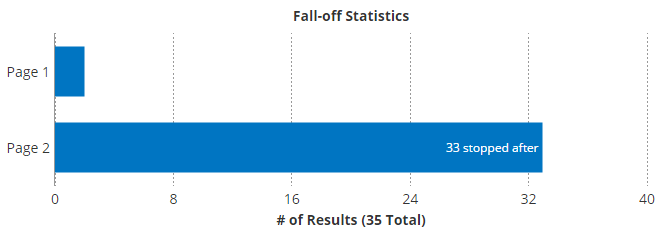Prevent Multiple & Incomplete Form Results
 Forms that collect many results from a wide group of visitors run the risk of receiving duplicate or incomplete results. For example, posting the form link on a website or social media site may drive lots of traffic that can be great for the form, but may generate these lower-quality results in some cases. To increase the quality of form results, steps can be taken to prevent multiple and incomplete results while still supporting a large group of visitors.
Forms that collect many results from a wide group of visitors run the risk of receiving duplicate or incomplete results. For example, posting the form link on a website or social media site may drive lots of traffic that can be great for the form, but may generate these lower-quality results in some cases. To increase the quality of form results, steps can be taken to prevent multiple and incomplete results while still supporting a large group of visitors.
Prevent Multiple Results
There are two major strategies for preventing multiples from the same visitor:
![]() The first method is found under the Form Settings -> Security page and is labeled Prevent multiple submissions. This method prevents the same form from submitting a new result from the same computer and browser, which is typically sufficient for the majority of forms.
The first method is found under the Form Settings -> Security page and is labeled Prevent multiple submissions. This method prevents the same form from submitting a new result from the same computer and browser, which is typically sufficient for the majority of forms.
Pro’s & Con’s:
- This method is typically good for preventing accidental duplicates from visitors who use the same computer and browser, and doesn’t rely on the Results Table to track usage.
- If the visitor uses a different browser, clears their cache, restricts cookie use, or uses a private browsing window, the setting will not know to prevent additional visits.
- This method will prevent multiple submissions from the same computer, which may prevent multiple legitimate results if the computer is used by multiple different people.
 The second method is to set one of the form items to be Unique. The Unique setting compares the value entered with all of the other values in the Results Table and preventing duplicates. For example, if you want to make sure that everyone on the team votes only once, you can make the Email Address item unique.
The second method is to set one of the form items to be Unique. The Unique setting compares the value entered with all of the other values in the Results Table and preventing duplicates. For example, if you want to make sure that everyone on the team votes only once, you can make the Email Address item unique.
Pro’s & Con’s:
- The ability to collect multiple results from the same computer and browser without risk of the same person submitting more than once.
- This method will prevent multiple results regardless of where they are submitted from or if the visitor attempts to hide his/her identity.
- If the Results Table is cleared or the result is modified, the Unique setting may not trigger when a duplicate is submitted.
Helping to Avoid Incomplete Results
The other kind of lower-quality results are those that are incomplete, either with required items that aren’t answered or unsuccessful payment attempts. These results can usually be avoided with small changes to the form structure and better communication to the form visitors.
Tips for increasing complete results:
- If the form has multiple pages, when the visitor goes from page 1 to page 2 the result is created and marked incomplete. When the form is finally submitted its status is changed to complete. If you find that you are getting many incomplete results for your multi-page form, you can review the Analytics dashboard page to see where your visitors are ‘falling off’, then review the items on that page. You may find that you can move a troublesome item to the first page to prevent unqualified visitors from even beginning the form.

- Using Save & Return can help by letting visitors log in and return to the result so they can complete it over multiple visits. Be sure to either enable the setting to Always require login or place the Save & Return item before any form input items. If any fields are completed before going to the login page, those answers are lost when the visitor leaves the form to log in.
- Incomplete payment transactions are mostly unavoidable, but can be minimized by making sure the order form clearly shows the details and pricing of everything. While payments that are declined are a regular part of any payment processing system, those where the visitors abandon the payment for some other reason can be frustrating. The best option when that happens is to contact the visitor to see why they didn’t complete the transaction and to encourage them to retry.